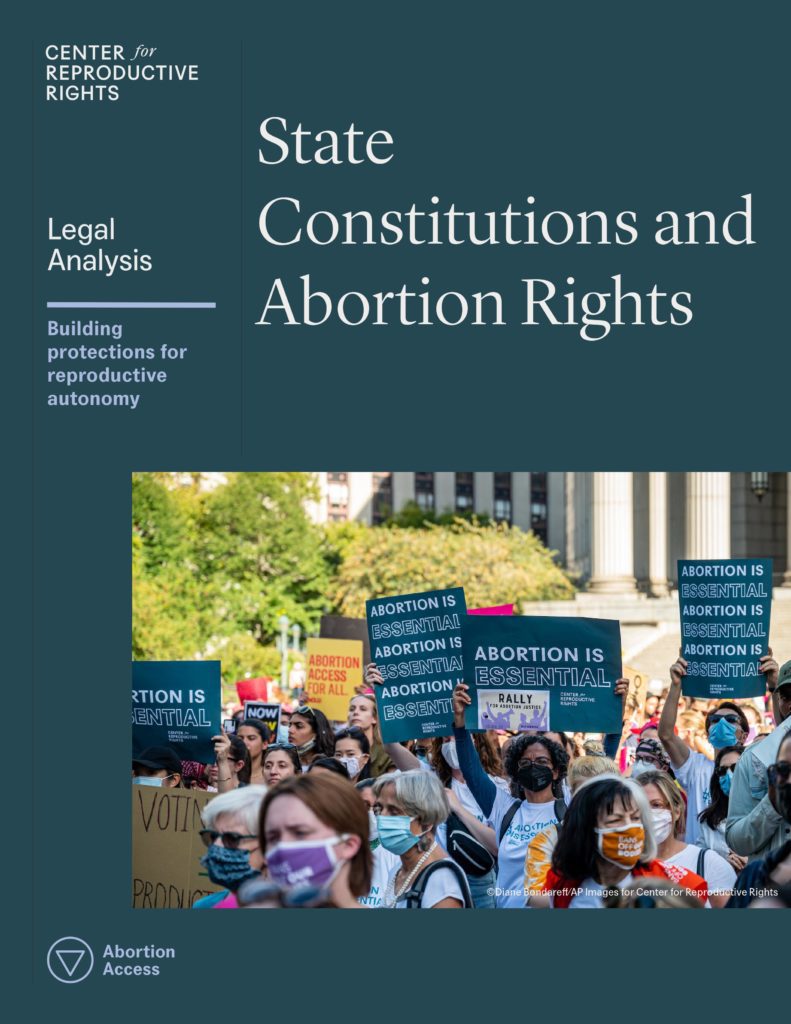
State Constitutions and Abortion Rights
Building Protections for Reproductive Autonomy
Now that the U.S. Supreme Court has taken away the constitutional right to abortion—in a devastating ruling in Dobbs v. Jackson Women’s Health Organization—state constitutions and courts matter more than ever. Not only do state courts and constitutions offer stronger and expanded legal grounds for protecting abortion rights, they also shield access to abortion in highly restrictive parts of the country.
For decades, the Center for Reproductive Rights has brought cases in state courts to build strong abortion protections at the state level independent of federal law. In a report published in July 2022, “State Constitutions and Abortion Rights: Building protections for reproductive autonomy,” the Center outlined 10 states in which high courts recognized that their state constitutions protect abortion rights and access independently from and more strongly than the U.S. Constitution or had struck down restrictions that were upheld by the U.S. Supreme Court. The report focuses on cases in seven states brought by the Center that not only resulted in broader protections for abortion rights and access, but have in many instances influenced outcomes in other cases and courts. The Center’s analysis also considers how this jurisprudence can expand and shape further efforts to secure reproductive rights.
The report is a snapshot of abortion rights in the states before a host of challenges to abortion bans that took effect after the Dobbs decision presented state courts with new opportunities to protect abortion rights.
Summary
The right to decide whether to continue a pregnancy is core to life, liberty, and equality—all rights protected under the U.S. Constitution. Human rights principles and international and comparative law recognize that abortion must be legal and accessible.
Even before overturning Roe, the U.S. Supreme Court and federal courts in the U.S. did not always treat abortion as a fundamental right that must receive the strongest possible protections against governmental interference. Some state courts and constitutions, however, have adopted more stringent legal standards, invalidating laws that infringe on decision-making about pregnancy.
Over the last three decades, state courts have built a foundation of novel jurisprudence that recognizes strong personal privacy and autonomy rights, equality principles, and the deeply rooted nature of abortion protections in history and text. With unique constitutions and court systems, states are free to guarantee greater protection for abortion rights and reproductive autonomy.
In Roe v. Wade (1973), the U.S. Supreme Court recognized abortion as a liberty right under the Fourteenth Amendment. In its ruling in the Dobbs v. Jackson Women’s Health Organization case, the U.S. Supreme Court abandoned its duty to protect fundamental rights by overturning Roe v. Wade and ruling there is no constitutional right to abortion. The decision marks the first time in history that the U.S. Supreme Court has taken away a fundamental right.
But even while Roe’s fundamental protection was in place, since 1992 the Court evaluated abortion regulations under an “undue burden” standard that permitted states to restrict abortion as long as burdens on access were not too severe. In practice, courts upheld a range of restrictions that made abortion difficult to access, especially for people of color, people living with low incomes, young people, immigrants, disabled people, and others with limited resources.
The rulings from seven state supreme courts detailed in the Center’s report have gone beyond the federal undue burden standard to protect abortion rights or access more strongly than the federal Constitution. The analysis explains each ruling’s legal underpinnings, impacts on abortion access, and positive influences on high courts in other states. In addition, the report considers how this jurisprudence can expand and shape future efforts to secure reproductive rights.
I. Historical Constitutional Analysis: State Traditions of Personal Autonomy
Some state courts have focused on how autonomy—the right to control one’s own body without influence or coercion—protects personal rights, including abortion. These state courts have interpreted their constitutional history and traditions more expansively than those federal jurists who have employed narrow, backward-looking analysis to reject rights such as intimacy, same-sex marriage, and abortion.
Read more about Center cases developing expansive versions of personal autonomy: Kansas, Montana
II. Abortion as a Fundamental Right: Decisions Grounded in Privacy
The U.S. Constitution does not include a textual right to privacy—the right to be free from government intrusion into personal life and decisions. While earlier U.S. Supreme Court and federal court opinions found that the right to liberty includes privacy, later opinions on the right to abortion moved away from a privacy analysis. State courts have relied on rights to privacy in their state constitutions to recognize the strongest protections for abortion.
Read more about Center cases developing rights to privacy: Alaska, Florida, Minnesota, Montana
III. Anti-Discrimination Principle: Decisions Requiring Equal Treatment for People Seeking Abortion
The U.S. Supreme Court has not held that abortion restrictions violate the federal Constitution’s equal protection guarantees—which protect the right of people to be treated equally under the law. In one context—a challenge to Medicaid funding for abortion brought in Harris v. McRae—the Court rejected an equal protection claim and upheld policies that discriminate against pregnant people with low incomes. In contrast, high courts in several states have struck down laws that treat people seeking abortion differently from those who choose to continue pregnancies; and in one state, treated an abortion restriction as a form of sex discrimination, which federal courts have failed to do.
Read more about Center cases treating abortion as a form of sex discrimination: Alaska, Arizona, New Mexico
Read more about the U.S. Supreme Court’s ruling.
Learn more about the June 24, 2022 ruling by the U.S. Supreme Court taking away the constitutional right to abortion in Dobbs v. Jackson Women’s Health Organization.

